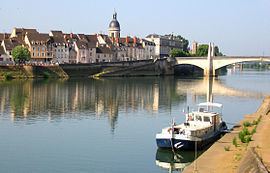Population (2013) 45,166 Local time Wednesday 10:17 PM | Intercommunality Le Grand Chalon Area 15.22 km² Number of airports 1 | |
 | ||
Region Bourgogne-Franche-Comté Weather 10°C, Wind S at 13 km/h, 88% Humidity Points of interest Museo Nicéphore‑Niépce, Chalon Cathedral, musée Vivant‑Denon, Parc Georges Nouelle, Tour du Doyenné | ||
Chalon-sur-Saône ([ʃa.lɔ̃.syʁ.son]) is a commune in the Saône-et-Loire department in the region of Bourgogne-Franche-Comté in eastern France.
Contents
- Map of 71100 Chalon sur SaC3B4ne France
- Geography
- History
- Main sights
- Economy
- Railway
- Road
- Air Transport
- Public Transport
- Education
- Events
- Personalities
- Tourism
- Twin towns sister cities
- References
Map of 71100 Chalon-sur-Sa%C3%B4ne, France
It is a sub-prefecture of the department. It is the largest city in the department; however, the department capital is the smaller city of Mâcon.
Geography
Chalon-sur-Saône lies in the south of the Bourgogne-Franche-Comté region of France. It is located on the Saône river, and was once a busy port, acting as a distribution point for local wines which were sent up and down the Saône river and the Canal du Centre, opened in 1792.
History
Though the site (ancient Cabillonum) was a capital of the Aedui and objects of La Tène culture have been retrieved from the bed of the river here, the first mention of Cavillonum is found in Caesar's Gallic Wars (VII, chs. 42 and 90). The Roman city already served as a river port and hub of road communications, of the Via Agrippa and side routes. In 354 AD the Roman Emperor, Constantius II stationed the Roman 7th Army in Chalon (then called Cabyllona) for an invasion against the brother kings, Gundomad and Vadomar of the Alamanni. However, not having received supplies, the Roman troops revolted, and were pacified by the grand chamberlain Eusebius with money. In Late Antiquity the city had dwindled so much that a wall round it encircled fifteen hectares.
Saint Marcellus of Chalons (Saint Marcel) is said to have been martyred here in 179 AD; his cult was encouraged by Guntram, king of Burgundy from 561 to 592, who died at Chalon. The bishopric of Chalon-sur-Saône, a suffragan of the Archdiocese of Lyon, was established here in the same century, and a Church Council was held here from 644–655. The see was merged into the diocese of Autun shortly after the French Revolution.
Chalon in the 19th century is best known as the birthplace of photography. Its most famous resident, Nicéphore Niépce also has a lycée (secondary school) named after him. There is a museum which contains some early photography relics, located on the Quai des Messageries in the town, containing more than two million photographs and many old artefacts such as cameras and other equipment for old and modern photography. Also on display are Niépce's 1807 Pyréolophore which is probably the world's first internal combustion engine, plus his 1818 implementation of a dandy horse, for which he coined the word vélocipède.
Another famous resident is Dominique Vivant Denon (1747–1825) who was involved in the creation of the Louvre museum, converting the former royal palace into a museum after the French Revolution.
Main sights
Economy
The primary industries are nuclear, plastics, metallurgy, and mechanics.
The Chamber of Commerce of Saône-et-Loire manages the École de Gestion et de Commerce de Chalon-sur-Saône, as well as the river port on the Saône.
There are 2472 businesses : 764 stores, 454 retail services, 409 schools and health and social services, 378 wholesale services, 122 construction companies, 69 agricultural and alimentary businesses, 64 real estate businesses, 60 transportation business, 49 industries de biens intermédiaires, 35 industries de biens de consommations, 34 entreprises d'énergie, 33 industries de biens d'équipements et 1 industrie automobile.
The most important companies are Areva, Saint-Gobain, Nordeon, Cartonnerie Laurent, Chalondis, Carrefour 2000, Géant Casino, Comptoirs des Fers, Cayon, Amazon and Le journal de Saône-et-Loire. Until the early 2000s, Kodak was the largest employer in town. Their production site became the campus of Le Grand Chalon en Bourgogne in 2005.
Railway
The Gare de Chalon-sur-Saône railway station offers connections with Paris, Dijon, Lyon and several regional destinations.
The station is located along the PLM mainline from Paris Gare de Lyon to Marseille-Saint-Charles, at kilometre post 382.150 from Paris.
Road
The primary national roads serving Chalon are the A6 autoroute from Paris to Lyon, the route nationale 73, from Chalon to Besançon and the route nationale 80, from Chalon to Montchanin.
The city is also located on the pan-European bicycle route the EuroVelo 6, which stretches from Saint-Nazaire on the Atlantic Ocean near Nantes to Constanta on the Black Sea.
Air Transport
The closest major commercial airport is Lyon-Saint-Exupéry, located about 120 kilometres away.
Public Transport
The public transportation company STAC offers a bus network ZOOM, including a free bus in the center, lines to surrounding communities, and services for handicapped riders. There also exists a bike sharing scheme Réflex.
Education
An institute of research of the engineering school Arts et Métiers ParisTech was established in Chalon in 1997. This institute offers graduate and doctoral programs in the domain of virtual reality and image engineering.
Events
Every year in July, Chalon-sur-Saône hosts an international street artists festival, called Chalon dans la Rue ("Chalon in the street"). Over four days, artists from across Europe and beyond come to the streets of Chalon to perform, mostly for free, in music, theatre, acrobatics, comedy, etc. A program is made available by the town, so people know of the main groups performing, and several newspapers report what performances are must-see and where and when to find them.
Personalities
Notable people associated with the city include:
Tourism
In Bourgogne-Franche-Comté, you can see :
Twin towns – sister cities
Chalon-sur-Saône is twinned with:
